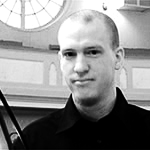Part I, Part II.
In the last part in this series I used the examples of Muse and The Smiths to illustrate how Paul Tillich's system of classifying art can be used to find the religious aspect in rock music. Now I will give to more examples, and finally get to the kind of music that, according to me and Tillich, is actually communicating something of that depth dimension in reality we commonly call God.
But first we have to look at some music that fits in the upper left corner of Tillich's diagram. This is music subjective in attitude and form oriented. Well, there is a lot of stuff that would fit in this sector. Take this clip of the Strokes for example. What is going on here? A couple of guys are standing around looking cool as f**k. The singer, looking cool, sings something about his life, but he is not really trying to say anything much, it's more about finding words that fit the kind of sound they are creating. Oh, and his foot must really hurt after kicking that mike-stand. To call this religious would be blasphemy. I won't say it's without merit, that guitar does sound nice, and its a good tune. But depth, no.
Most "Next big thing" type of artists tend to fit neatly into this category. It seems to me it is the most secular of all the categories in the diagram, and I have to confess, these types of bands rarely interest me much. Yes, good for parties and such, but not really for listening.
So then, what would be typical of a band with objective attitude that is gehalt-oriented? First of all lyrics would deal with the existential situation of man. It would be considered insufficient to describe the personal life of the lyricist or some fictional person in a way that connects with the listener. Attempts would be made to grasp something universal, something that is beyond the particular. There would be a tendency to break up the linear narrative of lyrics and create more fragmented pieces of images that together point to something beyond.
Further, the whole song would be created around this centre of the song that is created by the lyric, so that sounds, arrangements and instrumental parts would support and deepen the experience that is presented.
You have to forgive me for taking my favourite band as an example but it is really the best one I can think of. This has been the nature of most Radiohead songs from OK Computer onwards. Take Pyramid song off Amnesiac:
I jumped in the river and what did I see?
Black-eyed angels swam with me
A moon full of stars and astral cars
All the things I used to see
All my lovers were there with me
All my past and futures
And we all went to heaven in a little row boat
There was nothing to fear and nothing to doubt
This lyric is quite simple, just eight lines of text. The imagery is quite abstract: It suggests some kind of experience, maybe a dream or a vision, where the "I" of the song is experiencing something about our existence, the notion that in some way all the love we experience in life stays with us and that because of this there is 'nothing to fear and nothing to doubt'.
But the lyrics is just the starting point. The music adds so much to it. (If you haven't heard this song, I suggest that you do not watch the video yet, just listen to the music first) Those piano chords with that weird rhythm, those noises in the background that suggest a vast space around the subject of the song. It is all describing man's situation in the face of this faceless threat called death. Then the drums enter making the rhythm even more complex, adding to the feeling of existential commotion. In the middle of it all there arises this triumphant courage in the face of death, leading to this feeling calmness and trust at the end of the song.
To me this song says more about human existence, death and redemption than thousands of pages of top class theology. The experience of listening to this song is beyond the emotional, and the ego of the singer is completely irrelevant. By listening to this song something very fundamental in my being is moved, and this is an experience I wouldn't hesitate to call religious.
This is obviously not saying anything about the supposed religiosity of Thom Yorke and the other members of Radiohead (they have never said much positive about (organized) religion, with the exception of Buddhism). What I am saying is that this song (and there are many other songs that could be mentioned) can be interpreted as religious (or spiritual) in a very genuine way.
So here we have the diagram again, with my four examples placed in their respective sectors.

In the final part of this series I will address some of the problems of this system, and address why this may actually be a very significant and relevant line of theology.



